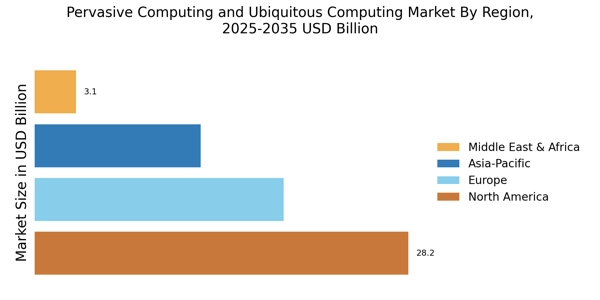Emergence of Edge Computing
The emergence of edge computing is poised to transform the Pervasive Computing and Ubiquitous Computing Market. By processing data closer to the source, edge computing reduces latency and enhances the performance of applications reliant on real-time data. This technology is particularly relevant in environments where immediate data processing is critical, such as autonomous vehicles and industrial automation. As organizations increasingly adopt edge computing solutions, the market is expected to witness substantial growth, with projections indicating a market size of 20 billion by 2025. This shift towards decentralized computing architectures is likely to bolster the capabilities of pervasive computing applications, thereby driving the overall growth of the Pervasive Computing and Ubiquitous Computing Market.
Advancements in IoT Technology
The rapid advancements in Internet of Things (IoT) technology are driving the Pervasive Computing and Ubiquitous Computing Market. As more devices become interconnected, the demand for seamless communication and data exchange increases. In 2025, it is estimated that the number of connected devices will surpass 30 billion, creating a vast ecosystem for pervasive computing applications. This proliferation of IoT devices enhances the ability to collect and analyze data in real-time, thereby improving decision-making processes across various sectors. Consequently, businesses are increasingly investing in IoT solutions to optimize operations and enhance customer experiences, further propelling the growth of the Pervasive Computing and Ubiquitous Computing Market.
Growing Demand for Smart Homes
The growing demand for smart home technologies is significantly influencing the Pervasive Computing and Ubiquitous Computing Market. Consumers are increasingly seeking convenience, energy efficiency, and enhanced security in their living spaces. By 2025, the smart home market is projected to reach a valuation of over 150 billion, indicating a robust interest in home automation solutions. This trend is fostering the development of various pervasive computing applications, such as smart lighting, security systems, and climate control. As manufacturers continue to innovate and integrate advanced technologies, the Pervasive Computing and Ubiquitous Computing Market is likely to experience substantial growth driven by consumer preferences for smart home solutions.
Increased Focus on Smart Cities
The increased focus on developing smart cities is a pivotal factor driving the Pervasive Computing and Ubiquitous Computing Market. Urbanization trends indicate that by 2025, nearly 68% of the world's population will reside in urban areas, necessitating the implementation of smart city solutions to manage resources efficiently. Technologies such as smart transportation systems, energy management, and waste management are integral to these initiatives. The investment in smart city projects is projected to exceed 1 trillion, highlighting the commitment to enhancing urban living through technology. This trend is likely to create numerous opportunities for the Pervasive Computing and Ubiquitous Computing Market as cities seek to leverage technology for improved infrastructure and services.
Expansion of Wearable Technology
The expansion of wearable technology is emerging as a key driver for the Pervasive Computing and Ubiquitous Computing Market. Wearable devices, such as smartwatches and fitness trackers, are becoming increasingly popular among consumers, with the market expected to reach 60 billion by 2025. These devices not only provide health and fitness tracking but also facilitate seamless connectivity with other smart devices. The integration of advanced sensors and data analytics in wearables enhances user experience and promotes health monitoring, which is particularly appealing in today's health-conscious society. As the adoption of wearable technology continues to rise, it is likely to significantly contribute to the growth of the Pervasive Computing and Ubiquitous Computing Market.


















Leave a Comment